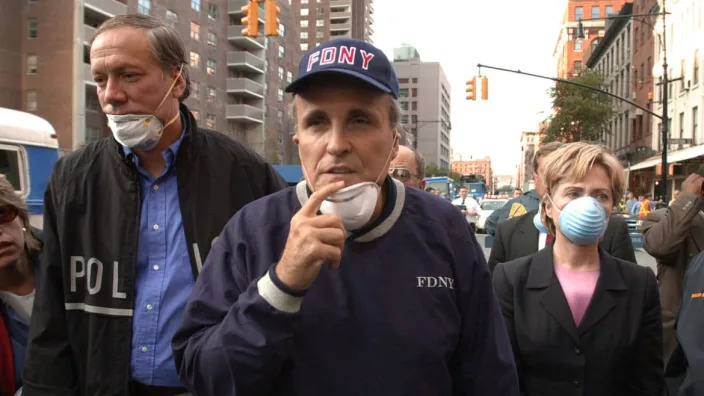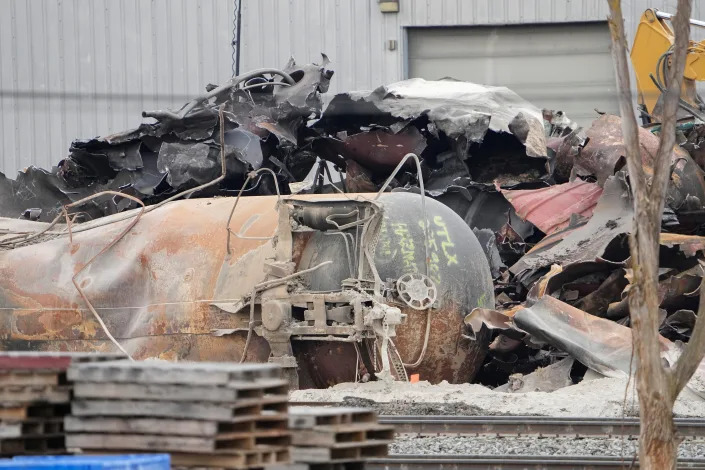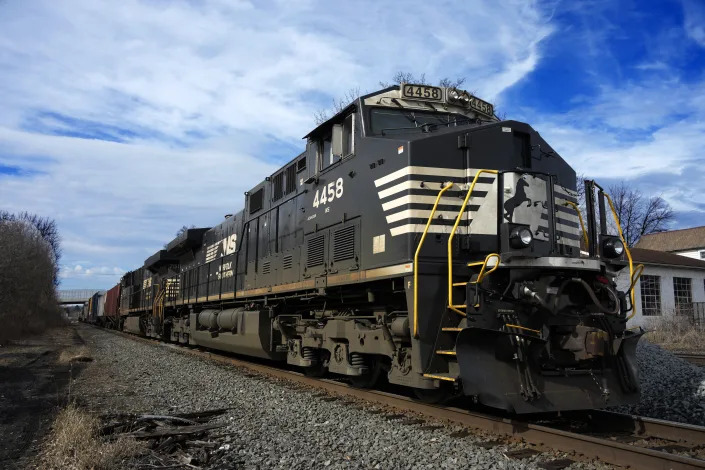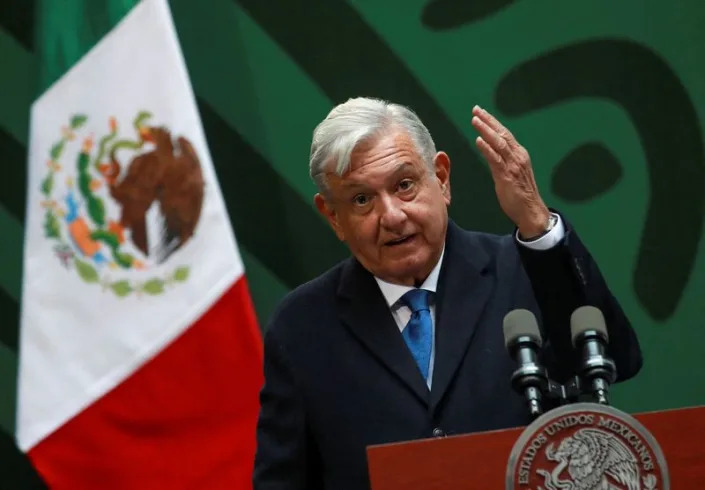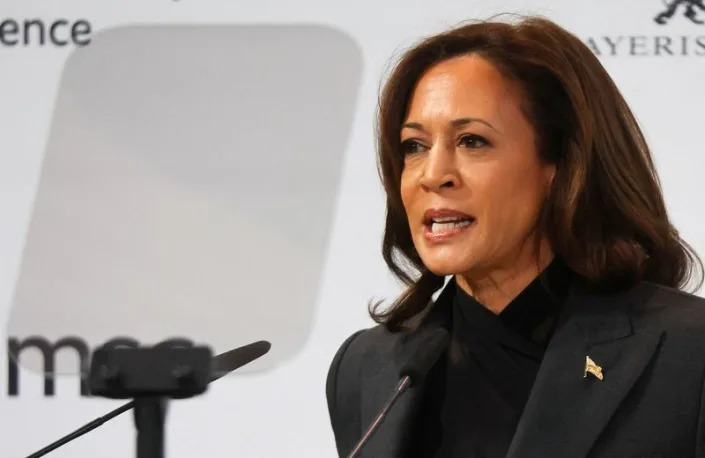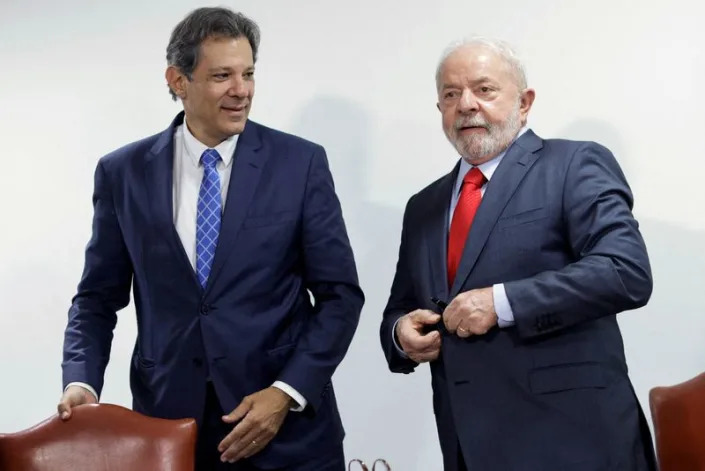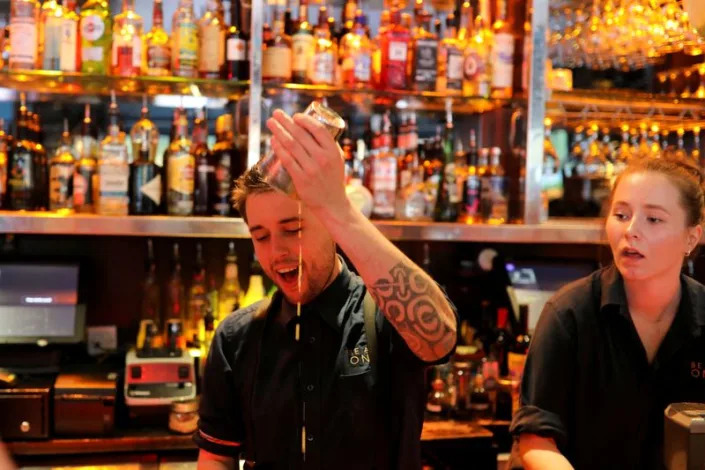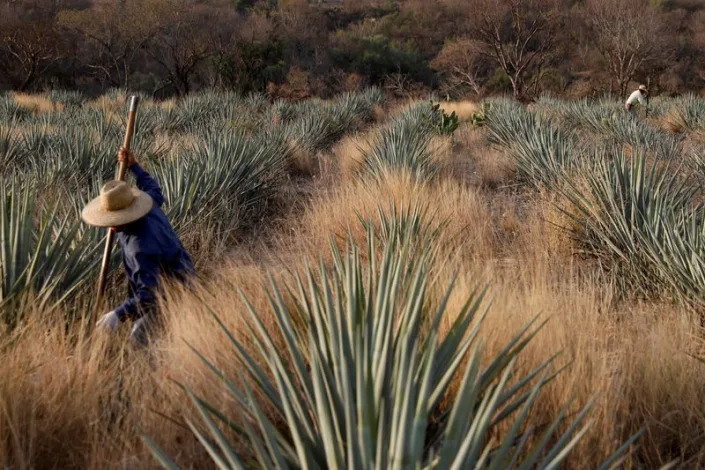Ben Adler
Senior Editor
YAHOO NEWS
Fri, February 24, 2023
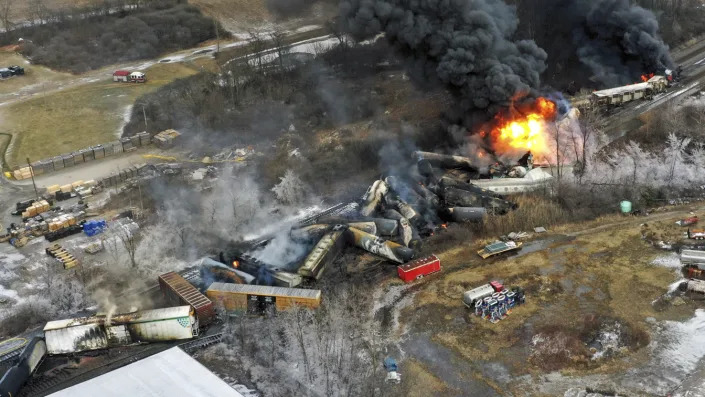
This photo, taken with a drone, shows part of a Norfolk Southern freight train still burning on the the day after the derailment in East Palestine, Ohio, on Feb. 4. (Gene J. Puskar/AP Photo)
In the wake of the Feb. 3 derailment of train cars carrying the toxic chemical vinyl chloride in East Palestine, Ohio, there has been increased focus on rail safety and whether the release of dangerous chemicals could have been averted.
The Norfolk Southern train was traveling eastbound from Madison, Ill., to Conway, Pa., when 38 cars derailed, and a fire broke out in 11 cars that were carrying hazardous materials. In order to prevent a deadly explosion of vinyl chloride, the company then performed a controlled burn, after which air and and water testing showed levels of the substance had dropped, and were now safe for humans. On Thursday, the Ohio state Department of Natural Resources estimated that more than 40,000 fish have died in surrounding waterways since the incident. Residents were told on Feb. 8 that it was safe to return, but since then, many have reported bloody noses, eye irritation, headaches and sick pets.
Vinyl chloride is used to make plastic, mostly polyvinyl chloride, more commonly known as PVC, which is used in products such as roofing materials and telecommunications wiring. Prolonged vinyl chloride exposure — for example among workers in factories producing it — is associated with a heightened risk of liver cancer, brain and lung cancers, lymphoma and leukemia, according to the National Cancer Institute, but PVC is not a known carcinogen for consumers.

Officials continue to inspect the area around the train derailment on Feb. 17.

Ron Fodo, of Ohio EPA Emergency Response, looks for signs of fish in Leslie Run creek in East Palestine on Feb. 20, to check for chemicals that have settled at the bottom after the derailment. (Michael Swensen/Getty Images)
The American Chemistry Council, which represents chemical manufacturers, did not respond directly to questions about plastics, but pointed to a statement issued Wednesday by Chris Jahn, the trade organization’s president and chief executive officer.
“People are understandably concerned and question why we ship hazardous materials,” Jahn said. “We ship them because they are needed across the country and essential to everyday life. These materials are critical to providing safe drinking water, ensuring a plentiful food supply, producing life-saving medicines and medical equipment, and generating many types of energy.”
“The safe transportation of chemicals is a responsibility shared between chemical manufacturers, our transportation partners and the government,” he added. “ACC and its members are committed to working with our transportation partners along with policymakers and other stakeholders to promote the safety of the products of our industry and help protect the public from future accidents.”
Enck argues that the products in which PVC is used, such as water pipes, should be replaced with more sustainable alternatives, such as recycled copper pipes.
“PVC plastic is used to make children’s toys that they chew on, let’s just avoid that,” Enck said. “For years and years and years, I’ve been telling my friends and family, if I visit their home and I notice in the bathroom that there’s a vinyl shower curtain, I tell them to immediately get rid of it, because of the vinyl. And you know that new car smell, or new shower curtain smell? That’s vinyl, and you do not want to be smelling that.”
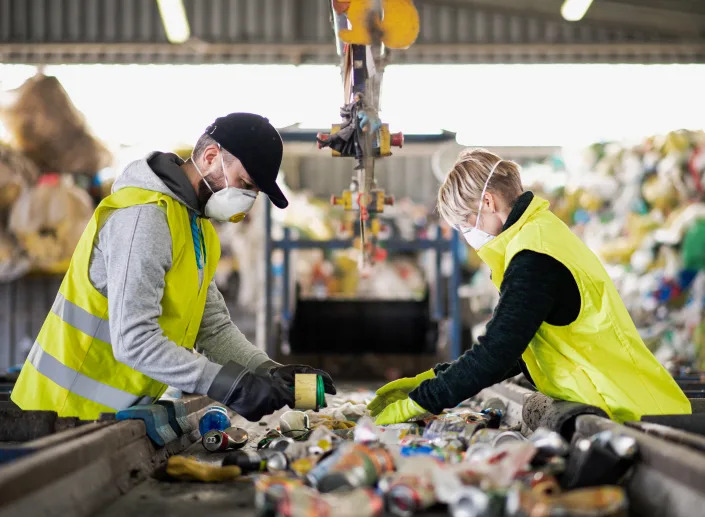
Two workers separating waste for recycling. (Getty Images)
Other forms of plastic may contain other contaminants. For example, styrene, in styrofoam, can cause eye and breathing problems when humans are exposed to it in large doses, and long-term exposure can cause nervous system damage, according to the CDC.
The Plastics Industry Association didn’t respond to a request for comment.
Despite the widespread existence of recycling programs, many forms of plastic are not recyclable, including PVC and styrofoam. The EPA estimated that in 2018, U.S. plastic waste had grown from 60 pounds per person per year in 1980 to 218 pounds per person in 2018, accounting for 18.5% of all solid waste in landfills — making it the second most common substance in landfills after food. Only 8.7% of plastic was recycled.
While it hasn’t released more recent figures, China’s decision that same year to stop accepting U.S. plastic for recycling — it said that most of the plastic was unsuitable for recycling and had to be discarded — has caused recycling rates to drop. Beyond Plastics estimates that the current U.S. plastic recycling rate is between 5% and 6%, because plastic is cheap to produce and expensive to sort and recycle. Globally, the Organisation for Economic Co-operation and Development (OECD) projects that plastic waste will triple from 350 million tons wasted in 2020 to 1 billion tons in 2060.
Some of that waste ends up in the oceans, where 10 million tons of plastic are dumped annually. And some ends up back in humans, who ingest it — for example, through seafood, since 100% of mussels tested for plastic contain some, according to the California-based nonprofit Plastic Oceans International.

A plastic water bottle floating in the Pacific Ocean off Santa Monica, Calif.

Plastic bails, left, and aluminum bails, right, at the Green Waste material recovery facility in March 2019, in San Jose, Calif. (Aric Crabb/Digital First Media/Bay Area News via Getty Images)
CIEL estimated in 2019 that if global plastic production continues to grow on its current trajectory, by the end of this decade, it will cause more annual carbon emissions than 295 new large coal-fired power plants. By 2050, plastic would consume 10% to 13% of the remaining carbon emissions that the world can allow if it is to stay under 1.5 degrees Celsius of global warming.
The petrochemical industry counters that plastic produces lower emissions than alternative materials and that the products made with plastic — from laptop chargers to MRI machines — help provide a higher quality of life.
Since plastic is so light, it requires less energy to produce and transport than materials such as metal, and it doesn’t require cutting down trees, like wood and paper. According to a July 2022 report from the consulting firm McKinsey, in 13 out of 14 examples it studied, plastic has the lower carbon footprint: PVC pipes produce less emissions than other pipes, plastic bags produce lower emissions than paper bags and so on.
“Our industry is committed to delivering solutions that enable a lower-carbon future, while simultaneously meeting the needs of the world’s growing population,” the American Petroleum Institute's vice president of downstream policy, Will Hupman, wrote in an email sent to Yahoo News via a spokesperson. “Plastics are critical to modern life, and U.S. petrochemical manufacturers are deploying innovative solutions and next generation technologies to reduce emissions throughout the supply chain.”
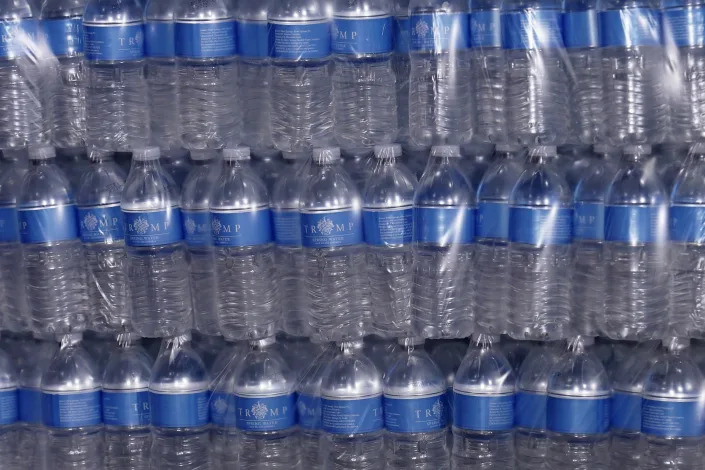
Personalized water bottles donated by former President Donald Trump on a pallet at the East Palestine Fire Department on Feb. 22, when he was visiting the area. (Matt Freed/AP Photo)
Anti-plastic activists counter that much of the packaging plastic is used for is unnecessary in the first place. Instead of using paper or plastic single-use bags, they say, why not switch to reusable bags?
They argue that the cost advantage of plastic is misleading, because the environmental costs to society are being borne by others, especially communities where plastic is produced. According to the National Cancer Institute, “the highest levels of vinyl chloride are found in air around factories that produce vinyl products.” Last year, a federal court revoked air pollution permits for a plastics plant planned in the Louisiana region called “Cancer Alley,” because emissions from the plant would violate air safety standards in an already polluted area.
“If someone were to come into our community… between 3 and 5 in the morning, they're going to be hit with these extremely pungent smells [like] … burning basketballs and sneakers, because a lot of the facilities are actually plastic-producing and resin-producing facilities,” Yvette Arellano, a resident of the Manchester neighborhood in Houston — which NPR previously described as “ringed by chemical plants” — told NPR in 2021. “A simple act of going to the park can be canceled by strong fumes emitting from down the waterway. It can be feeling sick, you know, having headaches, the need to throw up.”
Arellano runs an environmental justice advocacy group called Fenceline Watch, which issued a statement condemning Thursday’s announcement that toxic wastewater used to extinguish the East Palestine railcar fire will be disposed of in the Houston area, complaining that communities in Texas “are forced to absorb the deadly costs of these toxic disasters.”
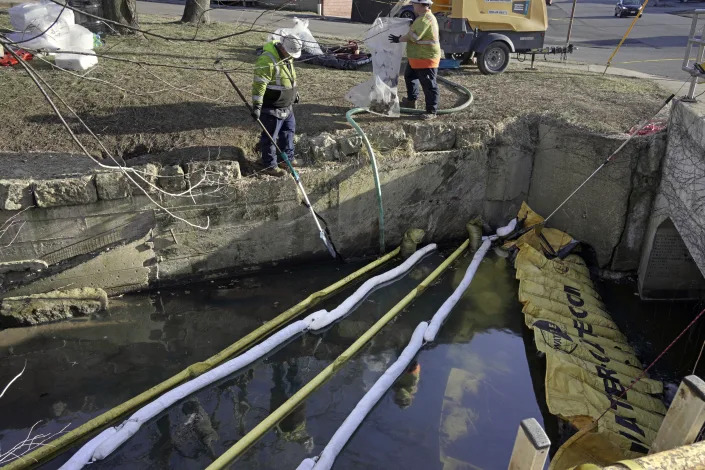
Booms are placed in a stream that flows through the center of East Palestine on Feb. 15, as cleanup continues. (Gene J. Puskar/AP Photo)
Environmentalists are pushing legislation at the federal and state levels to restrict the use of plastic. The Break Free From Plastic Pollution Act was introduced by Sen. Jeff Merkley, D-Ore., and Rep. Alan Lowenthal, D-Calif., in 2021, and Hocevar said it will be reintroduced this year. The bill would require producers of plastic packaging and containers to create and pay for programs to dispose of or recycle the waste created, ban some nonrecyclable, single-use plastic products and impose a fee on the plastic bags that remain.
Recognizing that passing an anti-plastic bill in Congress is unlikely in the near term — especially with a Republican majority in the House of Representatives — Beyond Plastics is pushing its own proposal at the state level, the Packaging Reduction and Recycling Act. In the past two years, it has been adopted in California, Oregon, Colorado and Maine. It requires over 10 years for packaging to be cut in half and made fully recyclable, and it imposes a fee on packaging. It also requires reductions of toxic substances and fully bans PVC in packaging. The bill has also been introduced in the New York and Massachusetts state Legislatures.
“I’m willing to go out on a limb and say when agencies say something is a human carcinogen and there are alternatives, we should use the alternatives,” Enck said.
“So much of the media focus [of the trail derailment] has been about the emergency response, and then who do you blame,” Enck said. “Few are asking the basic question: Do we really need vinyl chloride? The toxic train derailment is very much a plastic story.”
Fri, February 24, 2023
This photo, taken with a drone, shows part of a Norfolk Southern freight train still burning on the the day after the derailment in East Palestine, Ohio, on Feb. 4. (Gene J. Puskar/AP Photo)
In the wake of the Feb. 3 derailment of train cars carrying the toxic chemical vinyl chloride in East Palestine, Ohio, there has been increased focus on rail safety and whether the release of dangerous chemicals could have been averted.
The Norfolk Southern train was traveling eastbound from Madison, Ill., to Conway, Pa., when 38 cars derailed, and a fire broke out in 11 cars that were carrying hazardous materials. In order to prevent a deadly explosion of vinyl chloride, the company then performed a controlled burn, after which air and and water testing showed levels of the substance had dropped, and were now safe for humans. On Thursday, the Ohio state Department of Natural Resources estimated that more than 40,000 fish have died in surrounding waterways since the incident. Residents were told on Feb. 8 that it was safe to return, but since then, many have reported bloody noses, eye irritation, headaches and sick pets.
Vinyl chloride is used to make plastic, mostly polyvinyl chloride, more commonly known as PVC, which is used in products such as roofing materials and telecommunications wiring. Prolonged vinyl chloride exposure — for example among workers in factories producing it — is associated with a heightened risk of liver cancer, brain and lung cancers, lymphoma and leukemia, according to the National Cancer Institute, but PVC is not a known carcinogen for consumers.
Officials continue to inspect the area around the train derailment on Feb. 17.
(US Environmental Protection Agency/Handout/Anadolu Agency via Getty Images)
Some environmentalists argue that the root cause of the tragedy is the shipping of flammable, carcinogenic substances and that phasing down plastic production would be more effective in protecting public health than regulating freight trains.
“Should we be moving so much liquid vinyl chloride all over the country? My answer is no,” Judith Enck, a former regional administrator of the Environmental Protection Agency (EPA) who is now president of the advocacy organization Beyond Plastics, told Yahoo News.
Enck and her allies believe that plastic production should be reduced for a variety of reasons, including the health risks associated with the production and transportation of hazardous materials, the problem of plastic pollution in waterways, and the growing greenhouse gas emissions caused by plastic.
That idea, however, flies in the face of more than half a century of rapidly increasing plastic use. Worldwide plastic production has grown from 15 million metric tons in 1964 to 380 million metric tons per year today. In 2018, the last year for which EPA statistics are available, 35.7 million tons of plastic were produced in the United States. Plastic has become ubiquitous because it is lighter and cheaper to produce than metal, wood or glass, and more durable than some of those substances. All of the alternatives have their own environmental impacts, such as open pit mining and deforestation.
Some environmentalists argue that the root cause of the tragedy is the shipping of flammable, carcinogenic substances and that phasing down plastic production would be more effective in protecting public health than regulating freight trains.
“Should we be moving so much liquid vinyl chloride all over the country? My answer is no,” Judith Enck, a former regional administrator of the Environmental Protection Agency (EPA) who is now president of the advocacy organization Beyond Plastics, told Yahoo News.
Enck and her allies believe that plastic production should be reduced for a variety of reasons, including the health risks associated with the production and transportation of hazardous materials, the problem of plastic pollution in waterways, and the growing greenhouse gas emissions caused by plastic.
That idea, however, flies in the face of more than half a century of rapidly increasing plastic use. Worldwide plastic production has grown from 15 million metric tons in 1964 to 380 million metric tons per year today. In 2018, the last year for which EPA statistics are available, 35.7 million tons of plastic were produced in the United States. Plastic has become ubiquitous because it is lighter and cheaper to produce than metal, wood or glass, and more durable than some of those substances. All of the alternatives have their own environmental impacts, such as open pit mining and deforestation.
Ron Fodo, of Ohio EPA Emergency Response, looks for signs of fish in Leslie Run creek in East Palestine on Feb. 20, to check for chemicals that have settled at the bottom after the derailment. (Michael Swensen/Getty Images)
The American Chemistry Council, which represents chemical manufacturers, did not respond directly to questions about plastics, but pointed to a statement issued Wednesday by Chris Jahn, the trade organization’s president and chief executive officer.
“People are understandably concerned and question why we ship hazardous materials,” Jahn said. “We ship them because they are needed across the country and essential to everyday life. These materials are critical to providing safe drinking water, ensuring a plentiful food supply, producing life-saving medicines and medical equipment, and generating many types of energy.”
“The safe transportation of chemicals is a responsibility shared between chemical manufacturers, our transportation partners and the government,” he added. “ACC and its members are committed to working with our transportation partners along with policymakers and other stakeholders to promote the safety of the products of our industry and help protect the public from future accidents.”
Enck argues that the products in which PVC is used, such as water pipes, should be replaced with more sustainable alternatives, such as recycled copper pipes.
“PVC plastic is used to make children’s toys that they chew on, let’s just avoid that,” Enck said. “For years and years and years, I’ve been telling my friends and family, if I visit their home and I notice in the bathroom that there’s a vinyl shower curtain, I tell them to immediately get rid of it, because of the vinyl. And you know that new car smell, or new shower curtain smell? That’s vinyl, and you do not want to be smelling that.”
Two workers separating waste for recycling. (Getty Images)
Other forms of plastic may contain other contaminants. For example, styrene, in styrofoam, can cause eye and breathing problems when humans are exposed to it in large doses, and long-term exposure can cause nervous system damage, according to the CDC.
The Plastics Industry Association didn’t respond to a request for comment.
Despite the widespread existence of recycling programs, many forms of plastic are not recyclable, including PVC and styrofoam. The EPA estimated that in 2018, U.S. plastic waste had grown from 60 pounds per person per year in 1980 to 218 pounds per person in 2018, accounting for 18.5% of all solid waste in landfills — making it the second most common substance in landfills after food. Only 8.7% of plastic was recycled.
While it hasn’t released more recent figures, China’s decision that same year to stop accepting U.S. plastic for recycling — it said that most of the plastic was unsuitable for recycling and had to be discarded — has caused recycling rates to drop. Beyond Plastics estimates that the current U.S. plastic recycling rate is between 5% and 6%, because plastic is cheap to produce and expensive to sort and recycle. Globally, the Organisation for Economic Co-operation and Development (OECD) projects that plastic waste will triple from 350 million tons wasted in 2020 to 1 billion tons in 2060.
Some of that waste ends up in the oceans, where 10 million tons of plastic are dumped annually. And some ends up back in humans, who ingest it — for example, through seafood, since 100% of mussels tested for plastic contain some, according to the California-based nonprofit Plastic Oceans International.
A plastic water bottle floating in the Pacific Ocean off Santa Monica, Calif.
(Citizen of the Planet/Education Images/Universal Images Group via Getty Images)
When plastic is incinerated — the U.S. burns 12.5% of its waste — it releases greenhouse gases that contribute to global warming and it releases toxic chemicals such as nitrogen oxides and sulfur dioxide.
“A lot of people think of plastic as a problem of waste — we have to keep plastic out of the oceans or out of the environment — but the impacts of plastic are very serious throughout its whole life cycle,” said John Hocevar, oceans campaign director of Greenpeace USA. “Plastic harms human health, our climate and biodiversity, as well as environmental justice, from the very beginning: from the extraction of natural gas, which is the feedstock for plastic, to refineries, which poison the people nearby, to the everyday use of plastic, where thousands of chemicals are added to plastic with very little regulation … and finally, when plastic is discarded — either directly into the environment, or a landfill or an incinerator.”
As the environmental movement has become increasingly focused on combating climate change and ending the extraction of fossil fuels, plastic has also come under increasing scrutiny because it is made from oil or natural gas, which is refined into ethane or propane and combined at high heat with catalysts such as clays.
“From the wellheads and the drill pads where plastic feedstocks are born, to what happens to plastics when they, as they overwhelmingly do, end up in the environment — at every stage of that life cycle, plastics are emitting greenhouse gases into the atmosphere, often at extraordinary levels,” said Carroll Muffett, president and CEO of the Center for International Environmental Law (CIEL). “We see methane leakage from pipelines and distribution infrastructure. Then there are massive emissions associated with plastic refining and production itself. Plastic is among the most energy-intensive and among the highest-emitting among major industrial activities.”
When plastic is incinerated — the U.S. burns 12.5% of its waste — it releases greenhouse gases that contribute to global warming and it releases toxic chemicals such as nitrogen oxides and sulfur dioxide.
“A lot of people think of plastic as a problem of waste — we have to keep plastic out of the oceans or out of the environment — but the impacts of plastic are very serious throughout its whole life cycle,” said John Hocevar, oceans campaign director of Greenpeace USA. “Plastic harms human health, our climate and biodiversity, as well as environmental justice, from the very beginning: from the extraction of natural gas, which is the feedstock for plastic, to refineries, which poison the people nearby, to the everyday use of plastic, where thousands of chemicals are added to plastic with very little regulation … and finally, when plastic is discarded — either directly into the environment, or a landfill or an incinerator.”
As the environmental movement has become increasingly focused on combating climate change and ending the extraction of fossil fuels, plastic has also come under increasing scrutiny because it is made from oil or natural gas, which is refined into ethane or propane and combined at high heat with catalysts such as clays.
“From the wellheads and the drill pads where plastic feedstocks are born, to what happens to plastics when they, as they overwhelmingly do, end up in the environment — at every stage of that life cycle, plastics are emitting greenhouse gases into the atmosphere, often at extraordinary levels,” said Carroll Muffett, president and CEO of the Center for International Environmental Law (CIEL). “We see methane leakage from pipelines and distribution infrastructure. Then there are massive emissions associated with plastic refining and production itself. Plastic is among the most energy-intensive and among the highest-emitting among major industrial activities.”
Plastic bails, left, and aluminum bails, right, at the Green Waste material recovery facility in March 2019, in San Jose, Calif. (Aric Crabb/Digital First Media/Bay Area News via Getty Images)
CIEL estimated in 2019 that if global plastic production continues to grow on its current trajectory, by the end of this decade, it will cause more annual carbon emissions than 295 new large coal-fired power plants. By 2050, plastic would consume 10% to 13% of the remaining carbon emissions that the world can allow if it is to stay under 1.5 degrees Celsius of global warming.
The petrochemical industry counters that plastic produces lower emissions than alternative materials and that the products made with plastic — from laptop chargers to MRI machines — help provide a higher quality of life.
Since plastic is so light, it requires less energy to produce and transport than materials such as metal, and it doesn’t require cutting down trees, like wood and paper. According to a July 2022 report from the consulting firm McKinsey, in 13 out of 14 examples it studied, plastic has the lower carbon footprint: PVC pipes produce less emissions than other pipes, plastic bags produce lower emissions than paper bags and so on.
“Our industry is committed to delivering solutions that enable a lower-carbon future, while simultaneously meeting the needs of the world’s growing population,” the American Petroleum Institute's vice president of downstream policy, Will Hupman, wrote in an email sent to Yahoo News via a spokesperson. “Plastics are critical to modern life, and U.S. petrochemical manufacturers are deploying innovative solutions and next generation technologies to reduce emissions throughout the supply chain.”
Personalized water bottles donated by former President Donald Trump on a pallet at the East Palestine Fire Department on Feb. 22, when he was visiting the area. (Matt Freed/AP Photo)
Anti-plastic activists counter that much of the packaging plastic is used for is unnecessary in the first place. Instead of using paper or plastic single-use bags, they say, why not switch to reusable bags?
They argue that the cost advantage of plastic is misleading, because the environmental costs to society are being borne by others, especially communities where plastic is produced. According to the National Cancer Institute, “the highest levels of vinyl chloride are found in air around factories that produce vinyl products.” Last year, a federal court revoked air pollution permits for a plastics plant planned in the Louisiana region called “Cancer Alley,” because emissions from the plant would violate air safety standards in an already polluted area.
“If someone were to come into our community… between 3 and 5 in the morning, they're going to be hit with these extremely pungent smells [like] … burning basketballs and sneakers, because a lot of the facilities are actually plastic-producing and resin-producing facilities,” Yvette Arellano, a resident of the Manchester neighborhood in Houston — which NPR previously described as “ringed by chemical plants” — told NPR in 2021. “A simple act of going to the park can be canceled by strong fumes emitting from down the waterway. It can be feeling sick, you know, having headaches, the need to throw up.”
Arellano runs an environmental justice advocacy group called Fenceline Watch, which issued a statement condemning Thursday’s announcement that toxic wastewater used to extinguish the East Palestine railcar fire will be disposed of in the Houston area, complaining that communities in Texas “are forced to absorb the deadly costs of these toxic disasters.”
Booms are placed in a stream that flows through the center of East Palestine on Feb. 15, as cleanup continues. (Gene J. Puskar/AP Photo)
Environmentalists are pushing legislation at the federal and state levels to restrict the use of plastic. The Break Free From Plastic Pollution Act was introduced by Sen. Jeff Merkley, D-Ore., and Rep. Alan Lowenthal, D-Calif., in 2021, and Hocevar said it will be reintroduced this year. The bill would require producers of plastic packaging and containers to create and pay for programs to dispose of or recycle the waste created, ban some nonrecyclable, single-use plastic products and impose a fee on the plastic bags that remain.
Recognizing that passing an anti-plastic bill in Congress is unlikely in the near term — especially with a Republican majority in the House of Representatives — Beyond Plastics is pushing its own proposal at the state level, the Packaging Reduction and Recycling Act. In the past two years, it has been adopted in California, Oregon, Colorado and Maine. It requires over 10 years for packaging to be cut in half and made fully recyclable, and it imposes a fee on packaging. It also requires reductions of toxic substances and fully bans PVC in packaging. The bill has also been introduced in the New York and Massachusetts state Legislatures.
“I’m willing to go out on a limb and say when agencies say something is a human carcinogen and there are alternatives, we should use the alternatives,” Enck said.
“So much of the media focus [of the trail derailment] has been about the emergency response, and then who do you blame,” Enck said. “Few are asking the basic question: Do we really need vinyl chloride? The toxic train derailment is very much a plastic story.”


